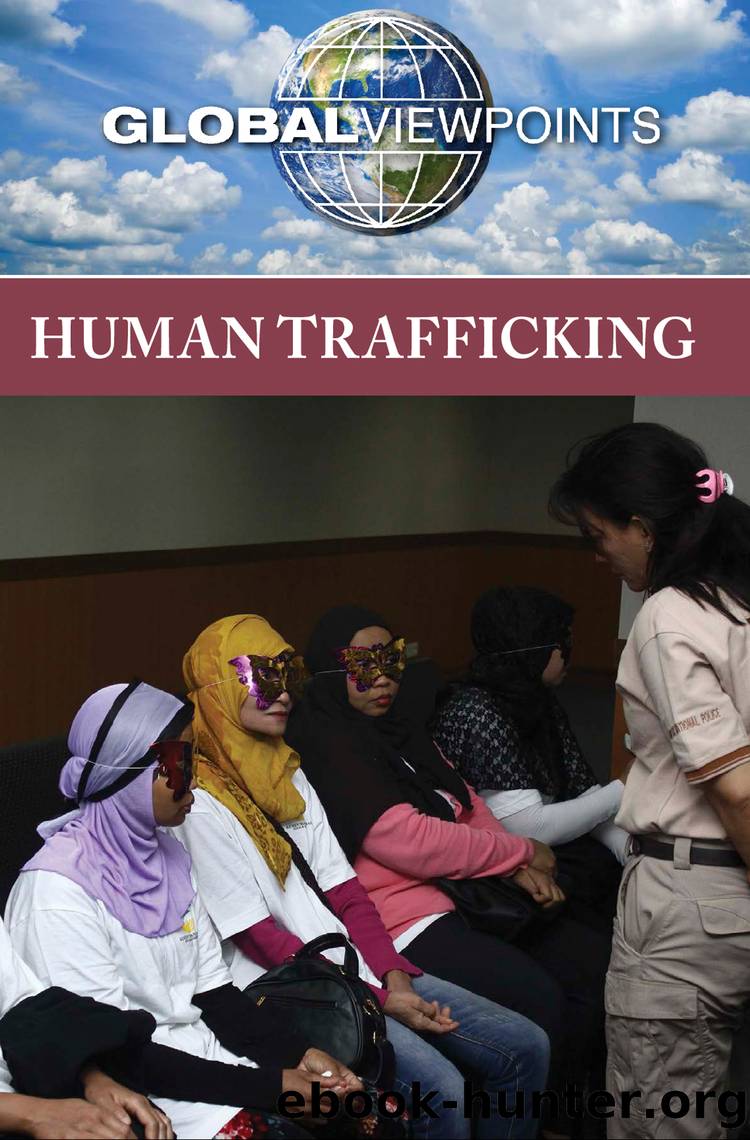Human Trafficking by Lita Sorensen

Author:Lita Sorensen
Language: eng
Format: epub
Publisher: Greenhaven Publishing LLC
Published: 2019-12-26T00:00:00+00:00
Trafficking and Smuggling
The UN definition of trafficking for forced labour and other forms of slavery concerns the recruitment, transportation, transfer, harbouring or receipt of people, by means of the threat or use of force or other forms of coercion, in order to achieve control over another person.
In practice, trafficking and smuggling overlap substantially but there are important distinctions:
⢠Smuggling involves explicit consent to be taken illegally across national borders. The relationship between smuggler and migrant typically ends when the destination is reached.
⢠Trafficking involves ongoing exploitation: even if the person has at some stage consented, this is meaningless because of the deception and coercion involved. Trafficking occurs within as well as across national borders.
How Extensive Is Slavery?
It is very difficult to compile precise statistics about the extent of slavery in the UK.
Official agencies, including the police and the Home Office, acknowledge that there are no reliable estimates for the number of trafficked people in the UK. The Solicitor General has suggested that more than 1,000 women were trafficked into the UK for sexual purposes (mainly from Eastern and Central Europe): this is recognised as a substantial underestimate. Others are trafficked for domestic labour. Perhaps thousands of young people have been trafficked through the UK to work as sex slaves elsewhere in Europe or as domestic labour in the UK. There are at least 5,000 child sex workers in the UK, most trafficked into the country. Many people trafficked into this country enter legally but then find themselves compelled to work as sexual or domestic slaves.
There are approximately 1.4 million registered foreign workers in the UK; estimates of the number of illegal workers range from about 300,000 to 800,000. Illegal workers are not necessarily slaves, and those working in slavery may have entered the UK either legally or illegally. The case studies show how even relatively skilled workers entering the country legally may find themselves working in enslaved conditions.
Worldwide, it is estimated that more than 12 million people may be working as slaves. These include at least 360,000 in industrialised countries, of whom at least 270,000 have been trafficked into forced labour. Of these, approximately 43 per cent are trafficked into sexual exploitation, approximately 32 per cent into labour exploitation and about 25 per cent are exploited for a mix of sexual and labour reasons.
The ILO estimates that the worldwide traffic in human beings is worth at least US$32 billion annually, just under half coming from traffic to industrialised countries. The ILO and UNICEF suggest that in 2004, 218 million children were trapped in child labour worldwide. Of these, by 2006, some 171 million were engaged in âhazardous workâ including in factories, mines and agriculture. In 2003, an estimated 3-4.5 million people were living in the European Union without legal papers, with an estimated 400,000 people a year being trafficked into member states.
Slavery in the UK: Some Issues
Where Are They Working?
Migrant workersâwhether illegal migrants or legal migrants working illegallyâare most at risk of slavery or slavery-like working conditions. They are found
Download
This site does not store any files on its server. We only index and link to content provided by other sites. Please contact the content providers to delete copyright contents if any and email us, we'll remove relevant links or contents immediately.
Welcome to Sex (Welcome To You Series) by Melissa Kang & Yumi Stynes(144)
Always Smile by Alice Kuipers(114)
Accountable by Dashka Slater(90)
The DBT Skills Workbook For Teens - Understand Your Emotions and Manage Anxiety, Anger, and Other Negativity To Balance Your Life For The Better by Bucket The Mentor(85)
Choosing to Live, Choosing to Die by Tate Nikki;Wuthrich Belle;(79)
Sex: A Book for Teens by Nikol Hasler(76)
The World Between Us by Sarah Ann Juckes(72)
Human Trafficking by Lita Sorensen(72)
The Fight for Disability Rights by Lisa A. Crayton(69)
The Gay Liberation Movement by Sean Heather K. McGraw(69)
Race Relations by Barbara Diggs(68)
Autism Playbook for Teens by Carol Moog(65)
The PTSD Survival Guide for Teens by Sheela Raja & Jaya Ashrafi(65)
Break The Silence (Tales of The Rikashi Book 1) by unknow(65)
Racism in America by Meghan Green(63)
It's Your Universe by Ashley Eckstein(62)
Gender Inequality in Sports: From Title IX to World Titles by Kirstin Cronn-Mills(62)
Inspired to Action by Jean Rawitt(62)
The Legend of Devil's Creek by D. C. Alexander(60)
